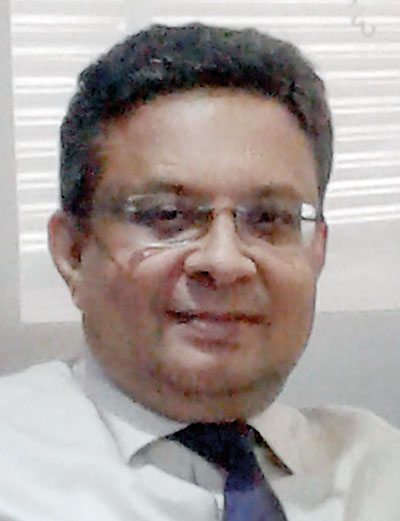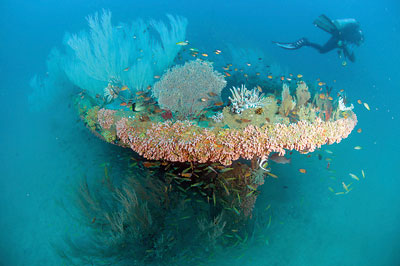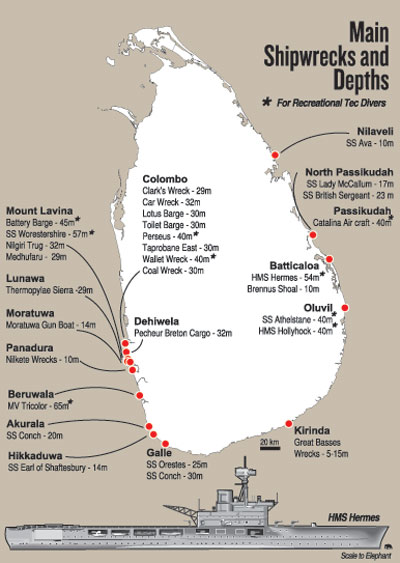Sunday Times 2
Shipwreck tourism: Lanka’s buried treasure
View(s):With hundreds of shipwrecks found around the coast, the country can be a divers’ paradise, say experts who call for measures to protect these wrecks from illegal salvagers and the dynamite fishing mafia. Randima Attygalle reports

Sutheash Balasubramaniam,

Dharshana Jayawardena and Terney Pradeep Kumara
Tourism in Sri Lanka has been a story of untapped potential, observes the Sri Lanka Tourism Strategic Plan (TSP). The country is missing opportunities to increase investment and jobs and to use tourism revenues to conserve the environment and sustainably support communities in all parts of the island, adds the 2017-2020 plan. By 2025, if we are to be identified as a ‘place for memorable, authentic and diverse tourism experiences,’ as envisaged by TSP, we need to move beyond the traditional image and branch out to emerging trends such as cuisine tourism, spiritual and health tourism and shipwreck tourism.
HMS Hermes, Battery Barge, Clark’s Wreck, SS Conch, Great Basses Wrecks — these are some of the shipwrecks lying off Sri Lanka’s coast — several of them found in the waters off Colombo. They are waiting to be marketed as niche tourist products. As the TSP notes, what is required is a ‘more focused, inclusive and tailored’ approach to address specific consumer needs. With a shift towards ‘unconventional’ tourism products, shipwreck tourism offers plenty of opportunities for Sri Lanka.
Among the mainstream and niche categories of tourist products cited in the TSP, it is interesting to note SCUBA and wreck diving are sought by ‘younger individuals’ below 35 years from all source markets. The shipwrecks scattered right around the coastal belt, including those in the emerging hot spots such as the east coast could optimise this trend. As the Managing Director, Sri Lanka Tourism Promotion Bureau (SLTPB), Sutheash Balasubramaniam tells the Sunday Times, the expectations of the new generation have taken a different shift. “Unlike the situation five to ten years back, today the tourism sector is competitive. In the fast-growing Asian Pacific region, the choices are emerging and we need to differentiate ourselves from the rest of the regional markets if we are to place ourselves offering niche products such as shipwreck tourism.”

Battery Barge: From shipwreck to sleeping beauty. Pic courtesy Dharshana Jayawardena
He says the ‘millennials’ look out for adventure in a different perspective, for which shipwreck tourism is an ideal experience. The product could also create ‘connections’, more specifically with the European tourist, says the SLTPB chief. “If we look at the shipwrecks the country claims, they are largely of British origin and the fact that most of them lie close to Colombo is a bonus as even one guest-night in the city means a lot of revenue.”
Shipwreck tourism also facilitates marketing of emerging destinations such as the east coast. The TSP observes that emerging hubs such as Batticaloa, Arugam Bay, Ella, Mannar, Passikudah and Kalpitiya, although of strategic value, face many challenges due to tangible and intangible infrastructure issues. “These places can emerge as tourism hubs, each with its own value proposition, with the right investment, management and community involvement,” the plan says. With considerable wrecks such as HMS Hermes, Brennus Shoal Wrecks (Batticaloa), SS Lady McCallum and SS British Sergeant (Passikudah) lying on the sea bed, opportunities are ample for community involvement and investment in facilities such as diving centres. Public-private partnerships in this regard are imperative, opines the SLTPB Chief.
Dharshana Jayawardena, a leading shipwreck explorer and author of ‘Ghosts of the Deep- Diving the Shipwrecks of Sri Lanka, says that compared to other South Asian countries, Sri Lanka has a high concentration of shipwrecks in a smaller area, providing a remarkable opportunity to earn the country millions of dollars in revenue in shipwreck diving tourism. “While several countries spend a fortune sinking old ships to promote shipwreck diving, we take our wrecks for granted,” he says citing the classic example of HMS Hermes — the world’s first purpose-designed aircraft carrier which sank off Batticaloa. wwAlthough it attracts only a few hundred tourist divers a year, its potential is actually 20 times more.
Of the hundreds of shipwrecks found around our coast, about 75 are divable. Since they lie at a depth of between 30-40m, even recreational divers can reach them.
Wrecks that lie at depths beyond 40m can be accessed only by specially trained technical divers. A single shipwreck in the Tulamben, Bali island in Indonesia is the source of sustenance for an entire village, Mr. Jayawardena points out. He says thousands of divers go there mainly to see the wreck, and as a result many dive centres, hotels and restaurants have come up, providing jobs to many people.
The dive industry in Sri Lanka is seasonal as only small boats are used. These boats can navigate only when the sea is calm. “It is difficult to launch these boats off the beaches. The diving season can be longer or in some of the monsoon-lull months if there are tourist-oriented marina facilities,” notes the expert, adding that the government is weak in protecting marine resources.
He says illegal metal salvage the shallow wrecks are subjected to and illegal dynamite fishing practised in several coastal areas have caused damage to the wrecks.
“Many fishermen and dive center operators in some of the coastal areas claim that the dynamite fishing mafia even collaborates with local politicians to carry out their destructive fishing method. Dive centres have charged that their boats have been stopped from approaching the wrecks at times when dynamite fishermen are engaged in blast-fishing. What is heartening to see is that, of late, the Navy has been taking a keen interest in marine conservation and taking action against dynamite fishing in the Nilaveli area. They have made several arrests,” Mr. Jayawardena says.
Regulating dive access to shipwrecks as mooted by some of the state authorities is not practical and sustainable, says Mr. Jayawardena who maintains that the country cannot claim the numbers to regulate. “First we need to build the numbers of dive tourists. To nurture the industry and get it to reach a good volume, the Government must just let the dive centers take divers to the wrecks without having to seek permission or going through red-tape. Once we have built the tourist numbers and the volume, then we can think of regulating (introducing a marine park fee or a shipwreck diving tax).
“Besides, those who destroy the wrecks are not tourists but rather illegal shipwreck salvagers and dynamite fishermen. By regulating tourists, it makes it easier for the illegal forces to gain access to the wrecks undisturbed,” he says.
The expert diver also urges the authorities to seek the expertise of the specialists in the dive industry and thereby make it a proactive process.
If the country is to spur shipwreck tourism, mitigating coastal waste is imperative, notes Dr. Terney Pradeep Kumara, the CEO of the Marine Environment Protection Authority (MEPA) and Ruhuna University senior lecturer in Oceanography and Marine Geology. While the mounting non-degradable waste which is piled up along beaches, washed from the inlands, tarnishes the country’s image as a tourist paradise, micro plastic (tiny particles of degrading plastics) is killing the marine life.
Annually MEPA spends millions on coastal clean ups. “The expectations of the modern tourists are quite different to what they were years ago. They will look out for sustainable tourism destinations and swimming or diving along with plastic bottles is certainly not what they will want in return. Diving to a shipwreck in a mirror like, pure marine water is a blessing for a recreational diver,” says Dr. Pradeep Kumara who calls for a strong legal mechanism with teeth along with ‘spot fining’ and also community engagement to curb the menace of coastal waste.

